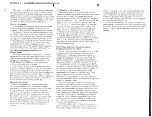
RATE] as required so you can use [DATA ENTRY] to
adjust Rate 3 to a value of 50.
When you play a note, observe how the sound builds
to a maximum, then falls to the sustain level at a
moderate rate and stays there until you release the
key, after which the sound slowly fades. If you could
see this new envelope, it would look something like
this:
*
The DX7 envelope rates are internally programmed so that each
segment of the envelope behaves similarly. A level of 99, whether it
is LEVEL I , 2, 3 or 4, is always the same. However, as mentionned
in the preceeding text, when a given rate is used for moving from a
lower to a higher level, that rate will be faster than if the envelope
is moving from a higher to a lower level. This is done because
naturally occuring "attack" times are typically faster than "decay"
or , "release" times. If all rates were scaled identically you might
have to work with the highest numbers for attacks and the lowest
numbers for decay or release. Instead, the DX7's "smart" program-
ming lets you maintain a full 100 step resolution within the range
you need it. This explains why even though Rate 1 and Rate 4 are
both 25 in this case. Rate 1 is faster; it is an upward moving rate.
NOTE If you are familiar with ADSR envelope genera-
tors, you'll probably see the similarity between this
envelope and the typical ADSR envelope. However, we
have not yet "used" Level 2, and it can significantly
alter the situation, as you ' l l now learn.
6. Press [EG LEVEL] until LEVEL 2 appears in the
display then adjust [DATA ENTRY] for a value of 45.
Then press [EG RATE] until RATE 2 appears in the
display and adjust [DATA ENTRY] for a value of 50.
Play a note and hold the key down for a full minute,
then release the note.
When you play the note, observe how the sound
builds to a maximum, then falls to almost nothing, then
builds to the intermediate sustain level and stays there
until you release the key after which the sound slowly
fades. This "double" note is made possible by the 4-
segment envelope which, if it were visible, would look
something like this:
7. At this point, you're ready to see one more "fine
point" about how the envelope functions. We showed
you how Rate 4 adjusts the release of the note as it
fades from Level 3 (the sustain level) to Level 4 (the
final level) which was set at zero. In fact. Rate 4 sets
the release time from whatever level the envelope has
achieved at the instant you release the key
This may seem a subtle distinction, but you can hear
it by experimenting with the envelope you have just
created.
8. Hold down the key until the note is well info Level 3
(the sustain level). Then release the key, and listen to
the length of time it takes for the sound to decay Play
several more notes, and compare that time to the
rather short time it takes for the sound to fall from the
initial peak at Level 1 to the low point at Level 2. The
difference is because Rate 2 is 50, which is considera-
bly faster than Rate 4, which is 25.
9. Now play a note and let go of the key just as the
sound reaches the first peak at Level 1. Notice how
long it takes for the sound to die away. Even though
Rate 2 and Level 2 are the next segment programmed
in the envelope, the sound is not moving toward
Level 2. Instead, because you released the key the
sound moves from Level 1 directly toward Level 4.
That's why Rate 4 (the slower rate) applies.
Remember, what you hear is coming from the same
EG settings you had established in Step 6 above. If
you could see what happens when you "prematurely"
let go of the key. the envelope might look like this.
Learning to change the operator
FREQUENCY settings
The frequency of the sine wave produced by each
operator can be set so it follows the keyboard. This
characteristic is set with the [OSCILLATOR-MODE/
SYNC] button, and is called "Frequency Ratio" mode
because the frequency produced when you play a key is
not necessarily tuned to the pitch of that key; it can be
multiplied by almost any number you wish by using the
[OSCILLATOR-FREQUENCY COARSE] and [OSCIL-
LATOR-FREQUENCY FINE] adjustments to repro-
gram the operator. For most voices, the DX7 is set to
this ratio mode. (The Voice Intialize function also-sets
the DX7 to ratio mode.)
The frequency does not have to follow the keyboard,
however. Instead, it can be set to a single frequency that
does not change regardless of which key you play. The
"REFS WHISTL" voice of the "Master Group" on the
#
3
DX7 VOICE ROM uses this "Fixed Frequency" mode.
While you can adjust the frequency characteristics of
operator 1 (fixed/ratio mode and actual frequency) using
the envelope you just created, we recommend changing
the envelope. The sustain level (Level 3) is now at 80,
and if you hold down a key to experiment with the fre-
quency settings, you will not hear it at full volume.
31
Summary of Contents for Vintage DX7 Special Edition ROM
Page 1: ...YAMAHA AUTHORIZED PRODUCT MANUAL DX7 DIGITALPROGRAMMABLE ALGORITHMSYNTHESIZER...
Page 2: ...YAMAHA DigitalProgrammable Algorithm Synthesizer OPERATION MANUAL...
Page 5: ......
Page 70: ...YAMAHA VOICE DATA LIST...
Page 71: ...DX7 OM 5 20 99 19E0112 international Corp Box 6600 Buena Park Calif 90622...









































